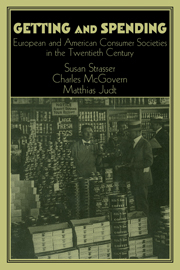Book contents
- Frontmatter
- Introduction
- Part One Politics, Markets, and the State
- 1 The Consumers' White Label Campaign of the National Consumers' League, 1898-1918
- 2 Consumption and Citizenship in the United States, 1900-1940
- 3 Changing Consumption Regimes in Europe, 1930-1970: Comparative Perspectives on the Distribution Problem
- 4 Customer Research as Public Relations: General Motors in the 1930s
- 5 The New Deal State and the Making of Citizen Consumers
- 6 Consumer Spending as State Project: Yesterday's Solutions and Today's Problems
- 7 The Emigré as Celebrant of American Consumer Culture: George Katona and Ernest Dichter
- 8 Dissolution of the “Dictatorship over Needs”?: Consumer Behavior and Economic Reform in East Germany in the 1960s
- Part Two Everyday Life
- Part Three History and Theory
- Index
3 - Changing Consumption Regimes in Europe, 1930-1970: Comparative Perspectives on the Distribution Problem
Published online by Cambridge University Press: 05 January 2013
- Frontmatter
- Introduction
- Part One Politics, Markets, and the State
- 1 The Consumers' White Label Campaign of the National Consumers' League, 1898-1918
- 2 Consumption and Citizenship in the United States, 1900-1940
- 3 Changing Consumption Regimes in Europe, 1930-1970: Comparative Perspectives on the Distribution Problem
- 4 Customer Research as Public Relations: General Motors in the 1930s
- 5 The New Deal State and the Making of Citizen Consumers
- 6 Consumer Spending as State Project: Yesterday's Solutions and Today's Problems
- 7 The Emigré as Celebrant of American Consumer Culture: George Katona and Ernest Dichter
- 8 Dissolution of the “Dictatorship over Needs”?: Consumer Behavior and Economic Reform in East Germany in the 1960s
- Part Two Everyday Life
- Part Three History and Theory
- Index
Summary
The evolution of modern systems of distribution is astonishingly understudied, considering that goods load up with meaning as they are moved from producers to purchasers. Here, I want to characterize this evolution from a particular perspective, namely, the changeover in continental Western Europe from what might be called a bourgeois to a Fordist mode of consumption. This transformation started to gather impetus in the 1920s and then met enormous resistance during the mid-1950s. Starting up again on wholly new economic, political, and social premises in the early 1950s, the evolution of mass distribution systems accelerated in the second half of the 1960s. By the early 1970s, Germany and France, as well as several smaller states including Belgium, Holland, Switzerland, and the Scandinavian countries, together with areas of north-central Italy, were at home with mass marketing, the supermarket, chain retailing, and the many other techniques and institutions that historians of the subject have characterized as the hallmarks of modern commerce. At least until recently: For the history of modern commerce now has a new endpoint, the so-called post-Fordist distribution systems using computerized communications systems to link segmented markets and vastly more intricate and dense global commodity chains.
- Type
- Chapter
- Information
- Getting and SpendingEuropean and American Consumer Societies in the Twentieth Century, pp. 59 - 84Publisher: Cambridge University PressPrint publication year: 1998
- 19
- Cited by



